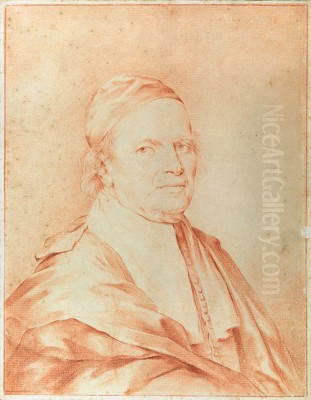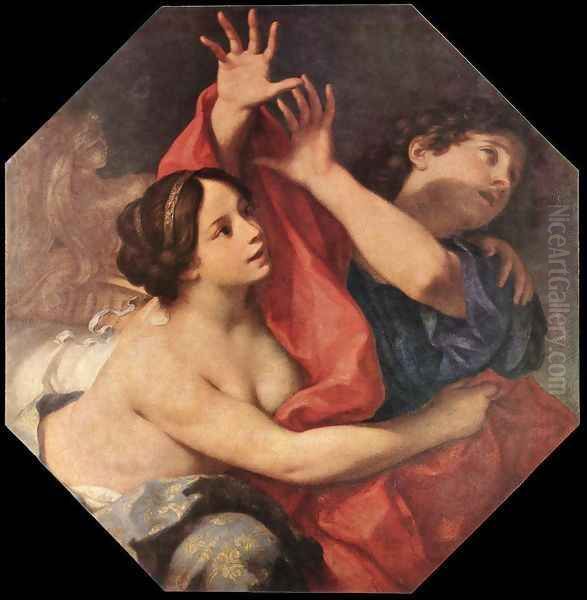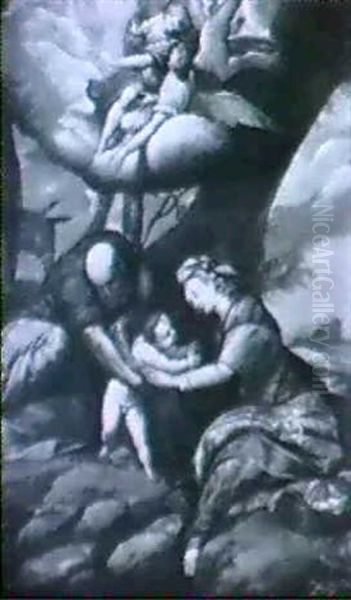
Carlo Cignani stands as a pivotal figure in the landscape of Italian Baroque art, particularly within the rich artistic milieu of Bologna during the late 17th and early 18th centuries. Born into a noble Bolognese family on May 15, 1628, Cignani's long life, extending until September 6, 1719, spanned a period of significant stylistic evolution in Italian painting. He was not merely a painter but also a skilled printmaker, leaving behind a legacy characterized by technical finesse, influential teaching, and a unique stylistic synthesis that bridged the gap between established traditions and emerging sensibilities.
His artistic journey began under the tutelage of Francesco Albani, a prominent master of the Bolognese school known for his graceful compositions and mythological scenes. However, Cignani's artistic vision was profoundly shaped by the enduring influence of Antonio Allegri da Correggio, the High Renaissance master celebrated for his sfumato technique and dynamic, illusionistic ceiling frescoes. Cignani absorbed these influences, forging a style often described as occupying a space between the lyrical classicism of Albani and the more idealized, elegant manner associated with Guido Reni, another giant of the Bolognese school.
Early Life and Formative Influences
Carlo Cignani's upbringing within a noble family in Bologna provided him with advantages, likely facilitating his entry into the city's vibrant artistic circles. His formal training commenced in the workshop of Francesco Albani, where he would have learned the fundamentals of drawing, composition, and the classical principles that underpinned the Bolognese tradition established by the Carracci family – Annibale, Agostino, and Ludovico Carracci – a generation earlier. Albani's emphasis on graceful figures and harmonious arrangements undoubtedly left an imprint on the young Cignani.

However, it was the art of Correggio that resonated most deeply with Cignani. Correggio's mastery of light and shadow (chiaroscuro), his ability to create soft, sensuous forms, and the breathtaking illusionism of his dome paintings, particularly in nearby Parma, offered a powerful model. Cignani studied Correggio's work intently, seeking to emulate its emotional warmth and technical brilliance. This deep admiration is evident throughout Cignani's career, manifesting in his handling of light, the softness of his figures, and his own ambitious fresco projects. The influence of Raphael, the epitome of High Renaissance classicism, is also noted, suggesting Cignani's engagement with the foundational figures of Italian art.
The Development of a Distinctive Style: The "New Manner"
As Cignani matured, he developed what contemporaries and later historians termed a "new manner" (nuova maniera). This style marked a departure from the more robust, energetic Baroque prevalent earlier in the 17th century. Instead, Cignani cultivated an approach characterized by reflectiveness, intimacy, and a refined elegance. His paintings often feature smooth, flowing lines, a sophisticated integration of deep colors, and a masterful interplay of light and shadow, creating a sense of gentle dynamism and emotional subtlety.
This "new manner" was not a radical break but rather a nuanced evolution. It retained the technical polish and compositional clarity valued by the Bolognese school, influenced by masters like Albani and Reni, but infused it with a softer, more introspective quality derived from Correggio. Some sources also note a connection to the dramatic chiaroscuro associated with Caravaggio, though Cignani's use of light tends towards atmospheric softness rather than stark, theatrical contrasts. His figures possess a certain grace and poise, often depicted in moments of quiet contemplation or tender interaction.
This distinctive style proved highly influential, impacting the direction of Bolognese painting at the turn of the 18th century. Artists like Guido Reni (though primarily an influence on Cignani, Cignani's later, softer style also resonated with Reni's legacy), the powerful Guercino (Giovanni Francesco Barbieri), and the sensitive Simone Cantarini are mentioned as artists whose work relates to or was influenced by the reflective qualities Cignani championed. His approach offered an alternative to more dramatic Baroque tendencies, emphasizing refinement and controlled emotion.
Masterpieces and Major Commissions
Carlo Cignani's reputation rests significantly on his large-scale fresco decorations, demanding projects that showcased his compositional skill and technical endurance. His most celebrated achievement is undoubtedly the decoration of the dome of the Cappella della Madonna del Fuoco (Chapel of the Madonna of the Fire) in the Forlì Cathedral. This monumental undertaking, depicting the Assumption of the Virgin, occupied the artist for approximately two decades, from roughly 1686 to 1706.

The Forlì dome is widely regarded as one of the most outstanding examples of Italian fresco painting from the latter half of the 17th century. Drawing inspiration from Correggio's dome frescoes in Parma, Cignani created a swirling, celestial vision, filled with dynamic figures ascending towards heavenly light. His sophisticated understanding of perspective (quadratura) and his ability to manage a vast, complex composition on a curved surface were fully realized in this work. The extended period required for its completion speaks to Cignani's meticulous, perhaps even slow and laborious, working method, a point sometimes raised by critics, but the final result cemented his fame. Its influence on subsequent dome painting can be seen in the works of artists like Gaudenzio Ferrari and Pordenone (Giovanni Antonio de' Sacchis), who tackled similar architectural challenges.
Beyond Forlì, Cignani received numerous other important commissions. He executed significant works for the Farnese Dukes of Parma, including mythological frescoes adorning the Palazzo del Giardino. These commissions demonstrate the high regard in which he was held by powerful patrons. He also created easel paintings on various themes. A notable example is Joseph and Potiphar's Wife, a work praised for its delicate coloration and the elegant rendering of the figures' poses. While depicting a dramatic biblical narrative involving temptation and accusation, Cignani's treatment emphasizes refinement and psychological nuance over overt violence or intense drama, consistent with his characteristic style.
Leadership at the Accademia Clementina
Carlo Cignani's influence extended beyond his own artistic production; he played a crucial role in the institutional framework of Bolognese art. He was a key figure in the establishment of the Accademia Clementina in Bologna in 1710. This academy aimed to uphold and promote the city's esteemed artistic traditions, particularly the emphasis on drawing (disegno) and classical principles inherited from the Carracci.
Significantly, Cignani was appointed as the first Principe (Director or President for life) of the Accademia Clementina. This prestigious position underscored his status as the leading painter in Bologna at the time, his authority comparable to that of Carlo Maratti in Rome. As director, Cignani was dedicated to nurturing the next generation of artists, ensuring the continuation of the Bolognese school's legacy. He actively participated in its activities, including overseeing the Accademia del Nudo (Academy of the Nude), which focused on life drawing, a cornerstone of academic training. His leadership provided stability and direction during the academy's formative years.
Students, Assistants, and Collaborators
As a respected master and head of a major workshop, Cignani trained and collaborated with numerous artists, significantly shaping the next generation. His most important student and chief assistant was Marcantonio Franceschini (1648-1729). Franceschini worked closely with Cignani for many years, assisting on major projects like the frescoes in the Palazzo del Giardino in Parma. He absorbed Cignani's elegant style but eventually developed his own successful career, becoming a leading painter in Bologna and beyond, known for his prolific output of altarpieces and decorative cycles.
Another notable student was Ferdinand Galli-Bibiena (1657-1743). While trained in painting under Cignani, Galli-Bibiena would achieve fame primarily in the fields of theatrical set design and architecture. Cignani recognized his talent and recommended him for service to the Duke of Parma, launching Galli-Bibiena's illustrious career, which saw him and his family become Europe's preeminent stage designers. This connection highlights Cignani's role not just as a teacher but also as a facilitator of opportunities for his pupils.
Cignani's workshop also included his brother-in-law, Luigi Quaini, who often collaborated with Marcantonio Franceschini after Cignani's move to Forlì to work on the cathedral dome. Together, Franceschini and Quaini undertook significant commissions in Bologna, such as frescoes in the churches of San Bartolomeo and San Severino, continuing a style closely related to Cignani's.
Other artists associated with Cignani include Giuseppe Maria Crespi (1665-1747), a highly original painter sometimes known as "Lo Spagnuolo." While Crespi developed a distinct, more genre-oriented style, Cignani invited him to study at the Accademia del Nudo, indicating a supportive relationship despite their differing artistic paths. The Roman painter Carlo Maratti, a dominant figure in the Roman art scene, also enters the network through Crespi, whom Maratti invited to Rome. Federico Bencelli (or Bencovich) is also mentioned among Cignani's students, further illustrating the reach of his teaching.
Patronage, Reputation, and Character
Throughout his long career, Carlo Cignani enjoyed considerable success and recognition. His refined style appealed to aristocratic patrons in Bologna, Rome, Florence, and Parma. His fame extended beyond Italy, with his works being sought after by collectors in Germany and Austria, indicating his international reputation. He received numerous invitations from nobles and royalty, though sources suggest he sometimes declined prestigious offers, preferring to focus on his artistic commitments, particularly the demanding Forlì commission.
Despite his success, Cignani apparently faced challenges, including jealousy from rivals. Anecdotes suggest that some envious individuals even attempted to damage his works to undermine his reputation. However, Cignani himself is described as having a humble and helpful personality. This disposition likely helped him navigate the competitive art world of the time and earned him widespread respect and friendship, contributing to his ability to lead the Accademia Clementina effectively. His dedication to his art remained unwavering throughout his life, continuing to paint even in his later years.
Influence and Lasting Legacy
Carlo Cignani's impact on the course of Italian painting, particularly within Bologna, was substantial. He is often considered the last great master of the Bolognese school, effectively transmitting its core values into the 18th century. His "new manner," with its emphasis on grace, intimacy, and refined light and shadow, provided a dominant stylistic model in Bologna during the late Baroque period.
His influence is clearly visible in the work of his direct students, most notably Marcantonio Franceschini, who carried forward a similar elegant classicism. Through Franceschini and others like Luigi Quaini and the Galli-Bibiena family (in their respective fields), Cignani's artistic lineage extended well into the 18th century. His style also resonated with contemporaries and slightly younger artists who adapted elements of his reflective approach, including figures like Guercino and Simone Cantarini, who were themselves significant artists.
Furthermore, his technical achievements, especially the Forlì dome, served as an important precedent for large-scale decorative painting. His ability to blend the illusionistic power pioneered by Correggio with the compositional clarity of the Bolognese tradition created a compelling synthesis. He effectively acted as a bridge, connecting the High Baroque energy of the mid-17th century with the more graceful, sometimes lighter sensibilities that would characterize Rococo and Neoclassical trends later in the 18th century.
Critical Reception and Historical Controversy
While Carlo Cignani was highly esteemed during his lifetime and recognized as a leading figure, art historical assessments have sometimes been mixed, reflecting evolving tastes and critical perspectives. There is broad agreement on his technical skill, his mastery of composition, particularly in large-scale frescoes, and his significant role as a teacher and leader of the Accademia Clementina. His Assumption of the Virgin in Forlì is consistently praised as a major monument of late Baroque decoration.
However, points of contention arise regarding the perceived originality and emotional depth of his work. Some critics have found his style overly academic, refined to the point of feeling artificial or lacking in genuine passion. His reliance on the models of Correggio, Albani, and the Carracci tradition has led some to view him as more of a skillful synthesizer than a radical innovator. His meticulous, slow working method has also been noted, sometimes implying a lack of spontaneity.
Comparisons are often drawn between his elegant, controlled style and the more dramatic or emotionally charged works of other Baroque masters. While his "new manner" was influential in its time for its intimacy and reflectiveness, later critics, perhaps favoring more overt dynamism or realism, sometimes found it wanting in vigor or profound feeling. His position as a transitional figure, bridging late Baroque classicism and emerging 18th-century styles, also means his work can be seen as conservative compared to more forward-looking trends elsewhere.
Despite these debates, Cignani's importance within the context of late 17th and early 18th-century Bolognese art remains undeniable. He successfully adapted and perpetuated the city's rich artistic heritage, creating works of undeniable beauty and technical accomplishment, and playing a vital role in educating the next generation of artists.
Conclusion
Carlo Cignani occupies a crucial position in the narrative of Italian Baroque art. As a student of Albani and an admirer of Correggio, he forged a distinctive style that blended classical grace with Baroque sensitivity to light and emotion. His "new manner" offered a refined, intimate alternative that resonated deeply within the Bolognese school and influenced key artists like Marcantonio Franceschini, Guercino, and Simone Cantarini. His monumental achievement in the Forlì Cathedral dome stands as a testament to his skill in fresco painting, while his leadership as the first Principe of the Accademia Clementina cemented his role as a guardian and promoter of Bologna's artistic traditions. Though subject to some critical debate regarding originality and emotional intensity, Carlo Cignani remains a significant master whose elegant works and influential teaching bridged the 17th and 18th centuries, leaving an indelible mark on the final flowering of the Bolognese Baroque.